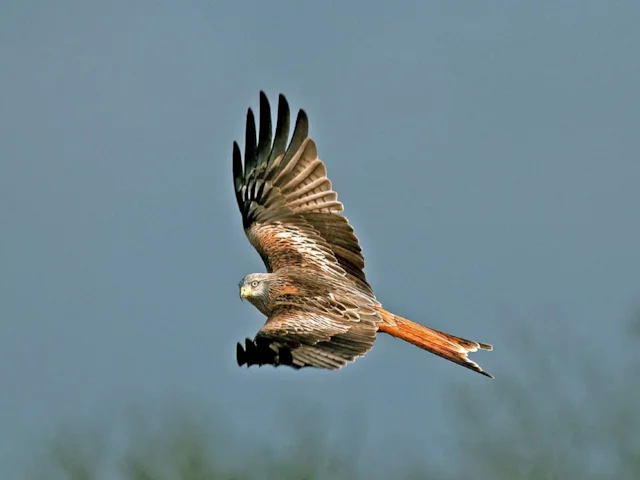Government 'FTSE Index' for wildlife confirms declines in Britain
4df8f18d-d9c7-4c21-a032-24379d32e6f0

The government has unveiled a new indicator for priority endangered species, dubbed a 'FTSE Index for threatened wildlife', which confirms declines noted by the State of Nature report.
The official statistic uses records dating back 40 years for 210 native species, including birds, bats, moths, butterflies, hares and dormice, to build a picture of the health of our wildlife. The figures show that priority species have declined on average by 58 per cent since 1970. This almost exactly echoes the findings of the State of Nature report, launched in May by Sir David Attenborough and 25 wildlife groups, that found a 60 per cent decline among key species.
The government's own list of species – issued along with the publication of the new statistic – represents wildlife in all four countries of the United Kingdom. Some have benefited from conservation efforts in recent years, such as Red Kite and Greater Horseshoe Bat, but others, including High Brown Fritillary and Skylark, have declined.
The government has previously published indicators for individual wildlife groups including birds, bats and butterflies, but never a wider view of our endangered wildlife.
Several taxa have not been included in the current indicator due to the difficulties of recording long-term trends – notably plants, molluscs and fungi. However the story is the same for these groups: conservationists estimate 97 per cent of Britain's wild flower meadows have been lost and 20 per cent of all UK flowering plant species are threatened with extinction.
Richard Gregory, RSPB Head of Species Monitoring, said: “This new indicator is like the FTSE Index for threatened species, and it is showing a steady, and very worrying decline. What this new official biodiversity statistic does is act as an indicator of the health of our countryside. Every year the government will be publishing these figures in the same way that they publish school league tables and crime statistics. We hope they will be a powerful new tool in the fight to halt the loss of our threatened native wildlife.
“These species were chosen mainly because they are under threat. Some of them are safer now than they were 40 years ago because of the hard work of conservationists, volunteers and government agencies, and we must celebrate some fantastic success stories. But the trend is downwards for 70 per cent of the species on this list. There is a great deal of wildlife not included in this list including endangered species like Freshwater Pearl Mussel. We will be working with the government to ensure data for these species are included in future to build a full picture of the state of our wildlife.”
Joan Edwards, The Wildlife Trusts’ Head of Living Seas, said: “We must remember the unsung heroes here: the legions of skilled amateur nature enthusiasts who have given up their spare time over many years to conduct surveys into everything from bees to Basking Sharks. Without them this would simply not be possible.”
The new biodiversity indicator for priority species is published as an official government statistic here.
The official statistic uses records dating back 40 years for 210 native species, including birds, bats, moths, butterflies, hares and dormice, to build a picture of the health of our wildlife. The figures show that priority species have declined on average by 58 per cent since 1970. This almost exactly echoes the findings of the State of Nature report, launched in May by Sir David Attenborough and 25 wildlife groups, that found a 60 per cent decline among key species.
The government's own list of species – issued along with the publication of the new statistic – represents wildlife in all four countries of the United Kingdom. Some have benefited from conservation efforts in recent years, such as Red Kite and Greater Horseshoe Bat, but others, including High Brown Fritillary and Skylark, have declined.
The government has previously published indicators for individual wildlife groups including birds, bats and butterflies, but never a wider view of our endangered wildlife.
Several taxa have not been included in the current indicator due to the difficulties of recording long-term trends – notably plants, molluscs and fungi. However the story is the same for these groups: conservationists estimate 97 per cent of Britain's wild flower meadows have been lost and 20 per cent of all UK flowering plant species are threatened with extinction.
Richard Gregory, RSPB Head of Species Monitoring, said: “This new indicator is like the FTSE Index for threatened species, and it is showing a steady, and very worrying decline. What this new official biodiversity statistic does is act as an indicator of the health of our countryside. Every year the government will be publishing these figures in the same way that they publish school league tables and crime statistics. We hope they will be a powerful new tool in the fight to halt the loss of our threatened native wildlife.
“These species were chosen mainly because they are under threat. Some of them are safer now than they were 40 years ago because of the hard work of conservationists, volunteers and government agencies, and we must celebrate some fantastic success stories. But the trend is downwards for 70 per cent of the species on this list. There is a great deal of wildlife not included in this list including endangered species like Freshwater Pearl Mussel. We will be working with the government to ensure data for these species are included in future to build a full picture of the state of our wildlife.”
Joan Edwards, The Wildlife Trusts’ Head of Living Seas, said: “We must remember the unsung heroes here: the legions of skilled amateur nature enthusiasts who have given up their spare time over many years to conduct surveys into everything from bees to Basking Sharks. Without them this would simply not be possible.”
The new biodiversity indicator for priority species is published as an official government statistic here.

